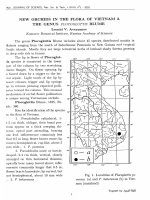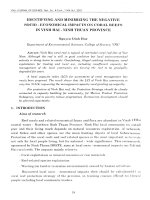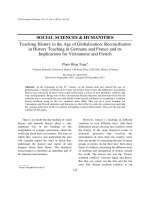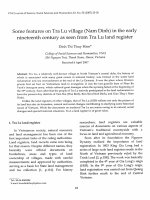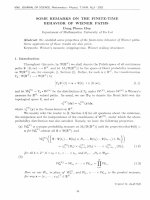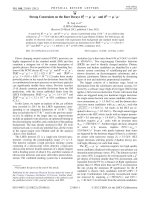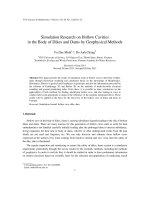DSpace at VNU: Experimental investigation on the effect of nanoparticles on micellization behavior of a surfactant: Application to EOR
Bạn đang xem bản rút gọn của tài liệu. Xem và tải ngay bản đầy đủ của tài liệu tại đây (774.2 KB, 8 trang )
Petroleum Science and Technology
ISSN: 1091-6466 (Print) 1532-2459 (Online) Journal homepage: />
Experimental investigation the effect of
nanoparticles on micellization behavior of a
surfactant: Application to EOR
Mohammad-Ali Ahmadi, Zainal Ahmad, Le Thi Kim Phung, Tomoaki
Kashiwao & Alireza Bahadori
To cite this article: Mohammad-Ali Ahmadi, Zainal Ahmad, Le Thi Kim Phung, Tomoaki
Kashiwao & Alireza Bahadori (2016) Experimental investigation the effect of nanoparticles on
micellization behavior of a surfactant: Application to EOR, Petroleum Science and Technology,
34:11-12, 1055-1061, DOI: 10.1080/10916466.2016.1148051
To link to this article: />
Published online: 12 Jul 2016.
Submit your article to this journal
Article views: 19
View related articles
View Crossmark data
Full Terms & Conditions of access and use can be found at
/>Download by: [University of Exeter]
Date: 21 July 2016, At: 11:59
PETROLEUM SCIENCE AND TECHNOLOGY
, VOL. , NOS. –, –
/>
Experimental investigation on the effect of nanoparticles on
micellization behavior of a surfactant: Application to EOR
Mohammad-Ali Ahmadia , Zainal Ahmadb , Le Thi Kim Phungc , Tomoaki Kashiwaod , and
Alireza Bahadorie
a
Downloaded by [University of Exeter] at 11:59 21 July 2016
Department of Petroleum Engineering, Ahwaz Faculty of Petroleum Engineering, Petroleum University of Technology,
Ahwaz, Iran; b School of Chemical Engineering, Engineering Campus, Universiti Sains Malaysia, Seri Ampangan, Nibong
Tebal, Penang, Malaysia; c Department of Chemical process and Equipment, Faculty of Chemical Engineering, Hochiminh
City University of Technology, Hochiminh City, Vietnam; d Department of Electronics and Control Engineering, National
Institute of Technology, Niihama College, Yagumo-cho, Niihama, Ehime, Japan; e School of Environmental Science and
Engineering, Southern Cross University, Lismore, Australia
ABSTRACT
KEYWORDS
Chemical stimulation such as surfactant flooding in petroleum reservoirs
makes efforts to produce remained oil and improve sweep efficiency by means
of different phenomena such as lowering interfacial tension and wettability
alteration of reservoir rock. Implementing concentration of surfactant through
surfactant flooding is one of the big challenges while interfacial tension
between surfactant solution and oil after certain concentration involves little changes such as critical micelle concentration (CMC). This article highlights
the effect of nanosilica on CMC of Zyziphus Spina Christi, as sugar-based surfactant, in aqueous solutions for enhanced oil recovery and reservoir stimulation purposes. A conductivity approach was selected to assess the CMC of the
introduced surfactant in aqueous solution at 25°C. The influence of nanosilica
concentrations on CMC variation of introduced surfactant is considered. It is
found that CMC of introduced surfactant decreased while the concentration
of the nanosilica increased. Results from this study can aim in optimum condition selection of surfactant flooding as an enhanced oil recovery ends.
Critical micelle
concentration; enhanced oil
recovery; hydrophobic;
nanosilia; sugar based
surfactant
1. Introduction
Surfactant flooding, which is normally classified as a subset of chemical enhanced oil recovery (EOR)
methods, has been taken as a solution to enhance the oil displacement sweep efficiency through decreasing the interfacial tension between oil and water (McAuliffe, 1973; Dranchuk et al., 1974; Johnson, 1976;
Kalfoglou, 1977; Farouq Ali et al., 1979; Mannhardt et al., 1990; Tsau et al., 2000; Grigg and Svec, 2003;
Liu et al., 2007).
Dependency of critical micelle concentration (CMC) of Zyziphus Spina Christi (ZSC) to nanosilica
is not yet reported in the literature. This article focuses on micellization behavior of ZSC in aqueous
solutions contain nanosilica. CMC measurement of the surfactant was determined via employing a conductivity method for aqueous phase. Results from this research are demonstrated and explained in detail
in subsequent sections.
CONTACT Alireza Bahadori
School of Environmental Science and Engineering, Southern Cross
University, Lismore,Australia.
Color versions of one or more of the figures in the article can be found online at www.tandfonline.com/lpet.
© Taylor & Francis Group, LLC
M.-A. AHMADI ET AL.
Downloaded by [University of Exeter] at 11:59 21 July 2016
1056
Figure . (a) The image of ZSC observed under TEM. (b) The image of nanosilica under TEM.
PETROLEUM SCIENCE AND TECHNOLOGY
1057
Table . Physical properties of nanoparticles.
Behavior with respect to water
Appearance
BET-surface area, m /g
Average primary particle size, nm
Tapped density, g/L
SiO , wt%
Al O , wt%
Fe O , wt%
TiO , wt%
HCl, wt%
AEROSIL
AEROSIL R
Hydrophilic
Fluffy white powder
±
ࣙ.
ࣘ.
ࣘ.
ࣘ.
ࣘ.
Hydrophobic
Fluffy white powder
±
ࣙ.
ࣘ.
ࣘ.
ࣘ.
ࣘ.
Downloaded by [University of Exeter] at 11:59 21 July 2016
Reprinted with permission from Mohammad Ali Ahmadi and Seyed Reza Shadizadeh, Adsorption of novel nonionic surfactant and
particles mixture in carbonates: Enhanced oil recovery implication, Energy & Fuels, :–. Copyright American Chemical
Society.
2. Experimental
2.1. Surfactant
One of the most popular trees in southern of Iran is ZSC. According to open literature ZSC contain high
concentration of saponins (Kjellim and Johansson, 2010). It should be mentioned here that saponins are
natural surface-active substances (surfactants) present in more than 500 plant species and the same as
other surfactant have hydrophilic and hydrophobic parts such as triterpenoid or steroid backbone and
saccharide residues (Hostettmann and Marston, 1995; Guglu-Ustundag and Mazza, 2007; Stanimirova
et al., 2011).
Through our research, we implemented extracted brown powder from leaves of ZSC, which contains
cyclopeptide alkaloids, as well as, saponin glycosides, and several flavonoids (Hostettmann and Marston,
1995; Guglu-Ustundag and Mazza, 2007; Stanimirova et al., 2011). To achieve main goal of current work,
the sugar-based surfactant was extracted from the leaves by spray dryer method while implemented
leaves of ZSC were collected from south of Iran (Khuzestan State) and the total extracted powder contains
Saponin and Flavonoids. In addition, Image under TEM for extracted powder from ZSC leaves are shown
in Figure 1a.
Figure . Conductivity versus surfactant concentration. Reprinted from Fuel, , M. A. Ahmadi and S. R. Shadizadeh, Experimental investigation of adsorption of a new nonionic surfactant on carbonate minerals, –, Copyright , with permission from Elsevier.
Downloaded by [University of Exeter] at 11:59 21 July 2016
1058
M.-A. AHMADI ET AL.
Figure . Effect of PPM of nanosilica on CMC of surfactant.
2.2. Nanoparticles
To obtain high precise results through this study, ultrapure nanosilica particles in different states were
implemented. According to wettability of the surface of the silica nanoparticles, they can be classified
into two types: hydrophilic silica nanoparticle (NSHI) and hydrophobic silica nanoparticle (NSHO).
To assess the referred purpose of this research, AEROSIL R 816 and AEROSIL 200 were carried out as
partially hydrophobic and hydrophilic nanoparticles which they were purchase from Degussa. Physical
properties of AEROSIL R816 and AEROSIL 200 are demonstrated in Table 1. In addition, Image under
TEM for hydrophobic nanosilica is illustrated in Figure 1b.
2.3. Preparation of Surfactant and Nanoparticle Solution
The stock solution of ZSC with concentrations of between 1000 and 80000 mg/L were prepared by dissolving 0.10–8 g of ZSC in 1000 mL deionized water in a volumetric flask. These solutions were then
diluted to obtain standard solutions containing 1000–80000 mg/L of the ZSC.
Figure . Effect of PPM of nanosilica on CMC of surfactant.
Downloaded by [University of Exeter] at 11:59 21 July 2016
PETROLEUM SCIENCE AND TECHNOLOGY
1059
Figure . Effect of PPM of nanosilica on CMC of surfactant.
Thickening and thixotropic effects of nanosilica at a given concentration depend to a great extent
on the intensity of the dispersing. Therefore the dispersion method is of crucial importance. As recommended by the producing companies, good results are achieved with ultrasonic homogenizer. An
ultrasonic homogenizer (UT-1200) has been implemented in this study to disperse the nanosilica particles in the aqueous media. The silica powder was weighed, wetted by the dispersing media (i.e., water)
and then dispersed using the ultrasonic homogenizer for more than 5–6 h.
... CMC Measurement
Various routs were carried out to figure out CMC of surfactant in aqueous solution based on different intrinsic characteristic of surface active agent such as surface tension, interfacial tension, thermal
conductivity, and electrical conductivity. Through this research based on high electrical conductance
behavior of introduced surfactant in aqueous solution, electrical conductivity measurement was selected
as robust and precise method to determine micellization behavior of introduced surfactant with/without
nanoparticles in aqueous solutions. To achieve end of this research, various concentration of introduced
surfactant was considered in range of 1000–80000 ppm and plots of electrical conductance versus surfactant concentrations for each nanoparticle concentrations were generated. It should be noted that a
conductivity detector from the Crison Company (EC-GLP 31+ ) was carried out through this research
work. Electrical conductivity trend for surfactant solution in various concentrations without nanoparticles is illustrated in Figure 2. This critical point should be mentioned here this is necessary to immerse
Figure . Effect of nanosilica on CMC value of surfactant.
1060
M.-A. AHMADI ET AL.
probe of the conductivity meter in solution to guarantee the accuracy and precision of solutions electrical
conductance.
Downloaded by [University of Exeter] at 11:59 21 July 2016
3. Results and Discussion
As known by chemical EOR experts, the value of CMC in surfactant flooding affects the performance
of the surfactant flooding in oil reservoirs because as a rule of thumb the amount of required surfactant
concentration for injection is two or three times of CMC value. Consequently, if CMC of the surfactant is high and cost of surfactant is high, then the performance of surfactant flooding from both an
economical and technical point of views is questionable. Moreover, the value of CMC also affects the
adsorption behavior of surfactant. This is another restriction parameter in surfactant flooding because
if the adsorption value of surfactant is high the applicability of surfactant is questionable again.
The changes in CMC with increasing the concentration of hydrophobic nanosilica are shown in
Figures 3, 4, and 5. As mentioned previously, turning point in plot of electrical conductivity against
surfactant concentration represent CMC of surfactant. Here we highlight micellization behavior of ZSC
in presence of different nanosilica such as hydrophilic nanosilica and partially hydrophobic nanosilica. Conductivity measurements revealed that at constant surfactant concentration, nanosilica presence,
either hydrophilic or slightly hydrophobic, had a very small effect on solution conductivity as shown
in Figure 6 for ZSC-AEROSIL 200/AEROSIL R816 systems. However, it seems that both nanoparticles
influence the surfactant micellization properties particularly its CMC. As can be seen in Figure 6, coexistence of ZSC and AEROSIL 200 nanosilica in a solution leaded to a CMC value lower that the one
for sole ZSC system. Figure 6 represents the CMCs of different systems considered in this study, it can
be seen that the presence of both nanoparticles have resulted in surfactant molecules to aggregate into
micelles at lower concentrations. This phenomenon is more severe for higher nanoparticle concentrations.
The observed phenomenon may be related to surfactant-nanoparticle interactions. Ignoring the little
amount of surfactant adsorption on nanoparticle surface, the similar negative electrical charge on the surfactant hydroxyl groups and nanoparticle surface results in an electrostatic repulsion between surfactant
molecules toward each other and prompts the micellization process. Moreover, the hydrophilic nanoparticles make the bulk solution unfavorable for hydrophobic surfactant tails and increase their affinity to
form micelles. Obviously, in such a situation, micelle aggregates form in lower concentration and CMC is
reduced, when nanoparticle concentration increase, the repulsion forces become stronger (due to larger
number of nanoparticles). Also, the bulk solution becomes more hydrophilic. As a result, micellization
occurs even at lower concentrations. Another important point that may be inferred from Figure 6 is that
the dramatic reduction of CMC is more considerable for hydrophilic AEROSIL 200 nanoparticles. As
mentioned previously, the presence of these nanoparticles intensifies the hydrophilic characteristics of
the solvent. As general rule, in aqueous medium, the greater the dissimilarity between the surfactant
hydrophobic chain and solvent, the grater the aggregation number. Consequently, sharper decrease in
CMC value is observed respect to AEROSIL R816 slightly hydrophobic nanoparticles.
4. Conclusions
Through this research, effects of the addition of different nanosilica particles on the micellization and
the micellar growth of ZSC in aqueous solution have been systematically investigated. From the results
obtained from this work the following conclusion can be drawn: ignoring the little amount of surfactant adsorption on nanoparticle surface, the similar negative electrical charge on the surfactant hydroxyl
groups and nanoparticle surface results in an electrostatic repulsion between surfactant molecules toward
each other and prompts the micellization process. In aqueous medium, the greater the dissimilarity
between the surfactant hydrophobic chain and solvent, the grater the aggregation number. Consequently,
sharper decrease in CMC value is observed respect to AEROSIL R816 slightly hydrophobic nanoparticles.
PETROLEUM SCIENCE AND TECHNOLOGY
1061
Downloaded by [University of Exeter] at 11:59 21 July 2016
References
Ahmadi, M. A., and Shadizadeh, S. R. (2012a). Adsorption of novel nonionic surfactant and particles mixture in carbonates:
Enhanced oil recovery implication. Energy Fuels 26:4655–4663.
Ahmadi, M. A., and Shadizadeh, S. R. (2013). Experimental investigation of adsorption of a new nonionic surfactant on
carbonate minerals. Fuel 104:462–467.
Dranchuk, P. M., Scott, J. D., and Flock, D. L. (1974). Effect of the addition of certain chemicals on oil recovery during
waterflooding. J. Can. Pet. Technol. 13:27–36.
Farouq Ali, S. M., Figueroa, J. M., and Azuaje, E. A. (1979). Effect of the addition of certain chemicals on oil recovery during
waterflooding. J. Can. Pet. Technol. 18:53–59.
Grigg, R. B., and Svec, R. K. (2003). SCA2003-19, International Symposium of the Society of Core Analysis, Pau, France,
September 22–25.
Guglu-Ustundag, O., and Mazza, G. (2007). Saponins: properties, applications and processing Crit. Rev. Food Sci. Nutr.
47:231–258.
Hostettmann, K., and Marston, A. (1995). Saponins. New York, NY: Cambridge University Press.
Johnson, C. E. (1976). Status of caustic and emulsion methods. J. Pet. Technol. 28:85–92.
Kalfoglou, G. (1977). Lignosulfonates as sacrificial agents in oil recovery processes. U.S. Patent No. 4,006,779.Kjellim, M.,
and Johansson, I. (2010). Surfactants from renewable resources. New York, NY: Wiley.
Liu, Q., Dong, M., Ma, S., and Tu, Y. (2007). Surfactant enhanced alkaline flooding for Western Canadian heavy oil recovery.
Colloids Surf., A 293:63–71.
Mannhardt, K., Schramm, L. L., and Novosad, J. J. (1990). Effect of rock type and brine composition on adsorption of two
foam-forming surfactants. SPE 20463, 1990 Annual Technique Conference and Exhibition, New Orleans, LA, September
26 .
McAuliffe, C. D. (1973). Oil-in-water emulsions and their flow properties in porous media. J. Pet. Technol. 25:727–733.
Michele, A. D., Brinchi, L., Profio, P. D., Germani, R., Savelli, G., and Onori, B. (2011). Effect of head group size, temperature
and counterion specificity on cationic micelles. J. Colloid Interface Sci. 358:160–166.
Stanimirova, R., K. Marinova, S., and Tcholakova, N. D. (2011). Surface rheology of saponin adsorption layers. Langmuir
27:12486–12498.
Tsau, J. S., Syahputra, A. E., and Grigg, R. B. (2000). Economic evaluation of surfactant adsorption in CO2 foam application.
SPE 59365, SPE/DOE 12th Improved Oil Recovery Symposium, Tulsa, OK, April .
